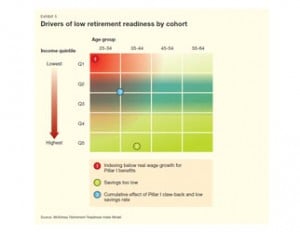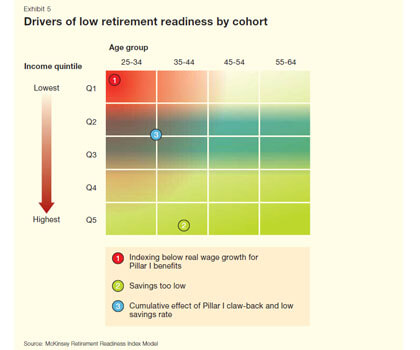Richest Canadians not saving enough, report finds
Roughly one-quarter of Canadian households are in for a real shock come retirement and higher-income earners are most vulnerable, according to a new study.
Advertisement
Roughly one-quarter of Canadian households are in for a real shock come retirement and higher-income earners are most vulnerable, according to a new study.
 Roughly one-quarter of Canadian households are in for a real shock come retirement and higher-income earners are most vulnerable, according to a new study.
McKinsey and Company studied the balance sheets of more than 10,000 Canadian working-age households in 2011 and found 23% of them aren’t building the kind of nest egg that will allow them to maintain their current lifestyle in retirement.
This group will have to “significantly adjust their standard of living or delay their retirement if they continue on the same savings path,” said the report entitled Are Canadians Ready for Retirement?
What’s more, higher-income Canadians appear to be in the worst shape. Thirty-eight per cent of younger high-income workers are ill-prepared for retirement and 41% in the older high-income category aren’t on the right track.
“In this cohort, unprepared households have failed to save sufficiently or have accumulated too much debt,” the report said.
That compares to just 4% in similar households earning much less.
That’s because lower income workers typically live more modest lifestyles and won’t notice much difference once their universal and workplace benefits such as the Guaranteed Income Supplement, Old Age Security and the Canada Pension Plan kick in.
But, as the report points out, this group is not out the woods either. OAS and GIS don’t typically keep up with real wage growth meaning there will be a significant erosion of retirement readiness over time.
As far as middle-aged, middle-income households are concerned, some 21% aren’t on track for a comfortable retirement.
“The primary challenge facing these households is the clawback of (universal) benefits,” the report said. Last month, the federal government announced plans to raise the OAS program eligibility age from 65 to 67 for anyone under the age of 54.
The consequence of all this is that even middle-income Canadians will have to rely more heavily on workplace and personal retirement savings to pay for expenses once they leave the working world.
For every $0.50 reduction in benefits, this group is expected to draw $1 from their registered accounts, including RRSPs, the McKinsey report estimates.
The graph below illustrates how higher-income Canadians will be left to their own devices come retirement, whereas lower-income earners will rely more heavily on universal benefits:
Roughly one-quarter of Canadian households are in for a real shock come retirement and higher-income earners are most vulnerable, according to a new study.
McKinsey and Company studied the balance sheets of more than 10,000 Canadian working-age households in 2011 and found 23% of them aren’t building the kind of nest egg that will allow them to maintain their current lifestyle in retirement.
This group will have to “significantly adjust their standard of living or delay their retirement if they continue on the same savings path,” said the report entitled Are Canadians Ready for Retirement?
What’s more, higher-income Canadians appear to be in the worst shape. Thirty-eight per cent of younger high-income workers are ill-prepared for retirement and 41% in the older high-income category aren’t on the right track.
“In this cohort, unprepared households have failed to save sufficiently or have accumulated too much debt,” the report said.
That compares to just 4% in similar households earning much less.
That’s because lower income workers typically live more modest lifestyles and won’t notice much difference once their universal and workplace benefits such as the Guaranteed Income Supplement, Old Age Security and the Canada Pension Plan kick in.
But, as the report points out, this group is not out the woods either. OAS and GIS don’t typically keep up with real wage growth meaning there will be a significant erosion of retirement readiness over time.
As far as middle-aged, middle-income households are concerned, some 21% aren’t on track for a comfortable retirement.
“The primary challenge facing these households is the clawback of (universal) benefits,” the report said. Last month, the federal government announced plans to raise the OAS program eligibility age from 65 to 67 for anyone under the age of 54.
The consequence of all this is that even middle-income Canadians will have to rely more heavily on workplace and personal retirement savings to pay for expenses once they leave the working world.
For every $0.50 reduction in benefits, this group is expected to draw $1 from their registered accounts, including RRSPs, the McKinsey report estimates.
The graph below illustrates how higher-income Canadians will be left to their own devices come retirement, whereas lower-income earners will rely more heavily on universal benefits:
 Overall, the study found that households with an employer-sponsored retirement plan, property or a financial adviser are better prepared for retirement.
The data also shows that non-homeowners, single-person households and single parents are more likely to “fall short” in retirement.
Perhaps most troubling however are the study’s findings suggesting many Canadians don’t have a clue what they are in for come retirement. McKinsey surveyed households and found no co-relation between confidence for retirement and actual readiness.
Overall, the study found that households with an employer-sponsored retirement plan, property or a financial adviser are better prepared for retirement.
The data also shows that non-homeowners, single-person households and single parents are more likely to “fall short” in retirement.
Perhaps most troubling however are the study’s findings suggesting many Canadians don’t have a clue what they are in for come retirement. McKinsey surveyed households and found no co-relation between confidence for retirement and actual readiness.
Share this article Share on Facebook Share on Twitter Share on Linkedin Share on Reddit Share on Email